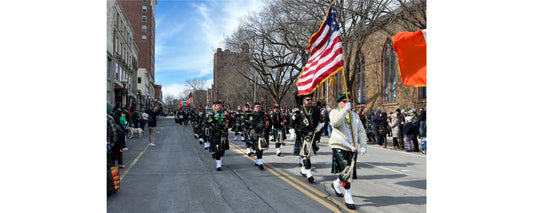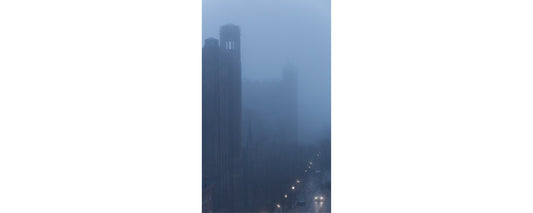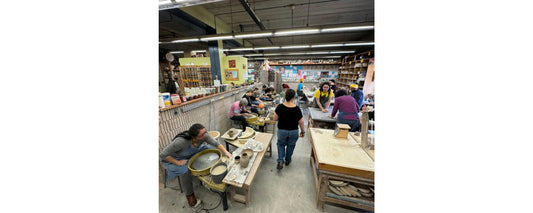In Christopher O’Flaherty’s New Haven studio, an enormous lighthouse stands in black and white, and a red cat prowls, flanked by blue ravens.
Here in the shadow of West Rock, framed in the window like a piece of art itself, O’Flaherty runs Lunch Money Print, where his and others’ prints are produced by human hands and manual presses. Along with his Boston-based cofounder Mark Donne, O’Flaherty aims to disrupt the mass-produced art industry—the pipeline for the stuff you see in hotels, doctors’ offices, even homes and dorm rooms—by providing easy, plentiful and even, if you like, rotating access to art prints that are still legitimately limited-edition.
Lunch Money started last October, but the roots for the idea were planted earlier, as O’Flaherty and his colleagues tried to sell their pieces the usual way. “At the time, it was all about me and my friends trying to place our artworks out in the world,” he says. “All of us have these great artworks, but we kept lowering our prices. But that didn’t help sales. So we wanted to form a collective of artists, to work together to create a platform to sell artwork.” Donne, who works on marketing and promotional videos for Lunch Money, came on board early this year.
sponsored by
Part of the idea was to have a “Collector’s Club,” where subscribers would receive a fresh print every three months. But O’Flaherty says a change is coming: a way for members to exchange their art if they like. “One of the problems of the club model… is people’s homes fill up too quickly,” he says. But if all goes to plan, starting this November, members will be able to swap out their artwork “whenever they like,” replacing old with new thanks to a program called NeueArt. That’s in addition to a more conventional e-commerce play: fine art prints sold a la carte on Lunch Money’s website, where unframed prices ranging from $60 to $400.
Like many printmakers, O’Flaherty started out as something else—a painter—and he says Lunch Money is expanding into photography as well as various kinds of prints. Through NeueArt, the business plans to distribute 20 artists’ works to start. “We’re just looking for strong artists,” he says, who can either print the work themselves or have Lunch Money print it on their behalf.
O’Flaherty moved to Connecticut as a teenager, graduating from the Lyme Academy of Fine Arts, in Old Lyme, in 2014. He then moved to Brooklyn for a little while, to “try out the whole artist thing,” where he had an epiphany. “Art seems really unobtainable for people, whether through fancy language or just price. So I wanted to also create this as a way to make artwork accessible, through affordability, videos showing how it’s made and other content,” he explains. The videos, which attend some of the items’ purchase pages, demonstrate the seemingly arcane, famously opaque processes behind manual printing.
O’Flaherty gave me an in-person demonstration. Choosing the paper was the first step, which also helped determine what kind of printing technique would be used. (Lighter paper can be printed by hand, while thicker paper with cotton added is typically printed on a manual press.) Ink was then rolled onto the plate—in this case a carved wooden block—which was then applied to the paper with a hand-cranked press.
Showing me one of his works, a limited-edition depiction of a grayscale schoolboy with a colored tie called Private School, he says, “This is a three-block woodcut, so each color is a different block of wood that has been carved,” O’Flaherty says. He notes that some of the textures on the block have been carved by a laser cutter at MakeHaven, others by hand. While his art takes inspiration from raw stylings of German expressionism and the patterns and colors of pop art, the themes of Lunch Money works vary greatly, from detailed New England imagery to provocative surrealist scenes to a neon-striped vision of Mexico’s patron saint.
As for the business’s name, O’Flaherty says, “We were thinking about sustainability, the idea of the starving artist and finding a way for them to have time to work in the studio and make some money out of it. Artists just need that little bit of money and promotion to keep them going.”
So do entrepreneurs, and Donne notes that the potential marketplace is large indeed. “Every home has a wall.”
Lunch Money Print
chris@christopheroflaherty.com
www.lunchmoneyprint.com
Written by Anne Ewbank. Photos 1-3, depicting detail of Christopher O’Flaherty’s Private School, LeeAnn Dicicco’s Virgen de Guadalupe and Jeffrey Fay’s If I Could Talk (Gayhead Light in Martha’s Vineyard MA), provided courtesy of Lunch Money Print. Photo 4, depicting Christopher O’Flaherty, by Anne Ewbank.








